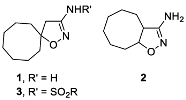3-[ N,N-Bis(sulfonyl)amino]isoxazolines with Spiro-Annulated or 1,2-Annulated Cyclooctane Rings Inhibit Reproduction of Tick-Borne Encephalitis, Yellow Fever, and West Nile Viruses
- PMID: 37445937
- PMCID: PMC10341786
- DOI: 10.3390/ijms241310758
3-[ N,N-Bis(sulfonyl)amino]isoxazolines with Spiro-Annulated or 1,2-Annulated Cyclooctane Rings Inhibit Reproduction of Tick-Borne Encephalitis, Yellow Fever, and West Nile Viruses
Abstract
Spirocyclic compounds containing heterocyclic moieties represent promising 3D scaffolds for modern drug design. In the search for novel anti-flaviviral agents, we have obtained a series of 3-[N,N-bis(sulfonyl)amino]isoxazolines containing spiro-annulated cyclooctane rings and assessed their antiviral activity against tick-borne encephalitis (TBEV), yellow fever (YFV), and West Nile (WNV) viruses. The structural analogs of spirocyclic compounds with a single sulfonyl group or 1,2-annulated cyclooctane ring were also investigated. Almost all the studied 3-[N,N-bis(sulfonyl)amino]isoxazolines revealed antiviral activity against TBEV and WNV. The most active against TBEV was spiro-isoxazoline derivative containing p-nitrophenyl groups in the sulfonyl part (EC50 2.0 ± 0.5 μM), while the highest potency against WNV was found for the compounds with lipophilic substituents in sulfonyl moiety, naphtyl being the most favorable one (EC50 1.3 ± 0.5 μM). In summary, two novel scaffolds of anti-flaviviral agents based on N,N-bis(sulfonyl)amino]isoxazoline were proposed, and the compounds of this type demonstrated activity against TBEV and WNV.
Keywords: 1,2-annulated compounds; West Nile virus; antivirals; isoxazolines; spiro-compounds; sulfonylation; tick-borne encephalitis virus; yellow fever virus.
Conflict of interest statement
The authors declare no conflict of interest.
Figures




Similar articles
-
Tetrahydroquinazoline N-oxide derivatives inhibit reproduction of tick-borne and mosquito-borne flaviviruses.Arch Pharm (Weinheim). 2023 Jul;356(7):e2300027. doi: 10.1002/ardp.202300027. Epub 2023 May 3. Arch Pharm (Weinheim). 2023. PMID: 37138375
-
Antibody ratios against NS1 antigens of tick-borne encephalitis and West Nile viruses support differential flavivirus serology in dogs.Transbound Emerg Dis. 2022 Sep;69(5):e2789-e2799. doi: 10.1111/tbed.14630. Epub 2022 Jul 1. Transbound Emerg Dis. 2022. PMID: 35704505
-
Seroprevalence of West Nile virus and tick-borne encephalitis virus in southeastern Turkey: first evidence for tick-borne encephalitis virus infections.Vector Borne Zoonotic Dis. 2007 Summer;7(2):157-61. doi: 10.1089/vbz.2006.0574. Vector Borne Zoonotic Dis. 2007. PMID: 17627432
-
Recent progress in West Nile virus diagnosis and vaccination.Vet Res. 2012 Mar 1;43(1):16. doi: 10.1186/1297-9716-43-16. Vet Res. 2012. PMID: 22380523 Free PMC article. Review.
-
[Tick-borne human pathogenic microorganisms found in Europe and those considered nonpathogenic. Part I: Ticks and Viruses].Bundesgesundheitsblatt Gesundheitsforschung Gesundheitsschutz. 2004 Apr;47(4):392-404. doi: 10.1007/s00103-003-0766-3. Bundesgesundheitsblatt Gesundheitsforschung Gesundheitsschutz. 2004. PMID: 15205783 Review. German.
References
-
- Kotha S., Panguluri N.R., Ali R. Design and Synthesis of Spirocycles. Eur. J. Org. Chem. 2017;2017:5316–5342. doi: 10.1002/ejoc.201700439. - DOI
MeSH terms
Substances
Grants and funding
LinkOut - more resources
Full Text Sources
Medical
Miscellaneous

